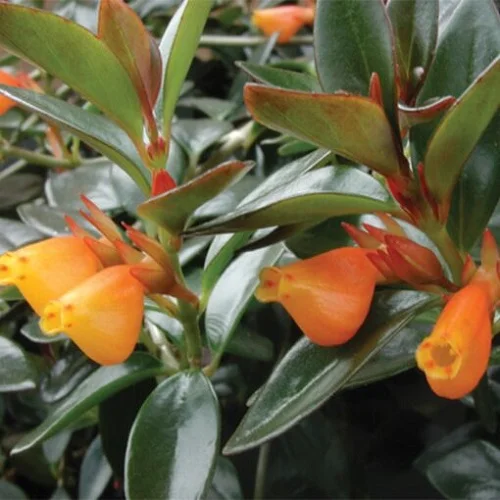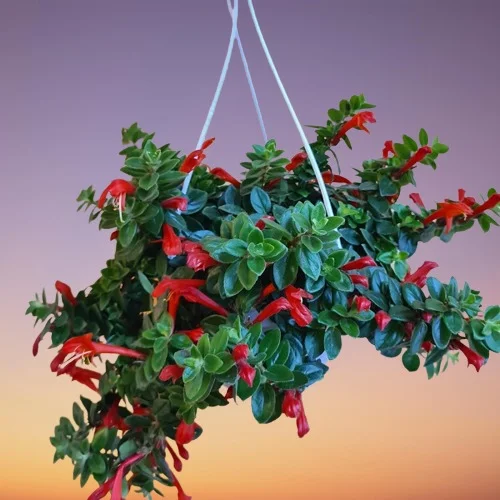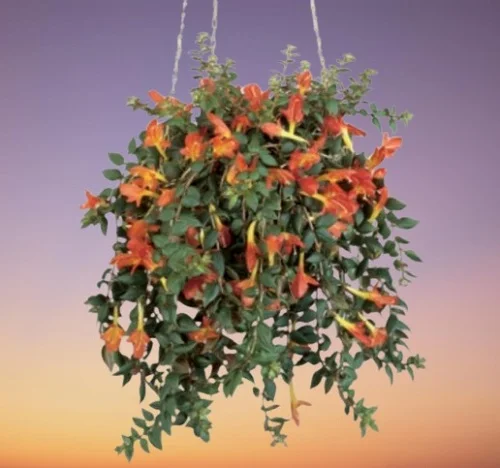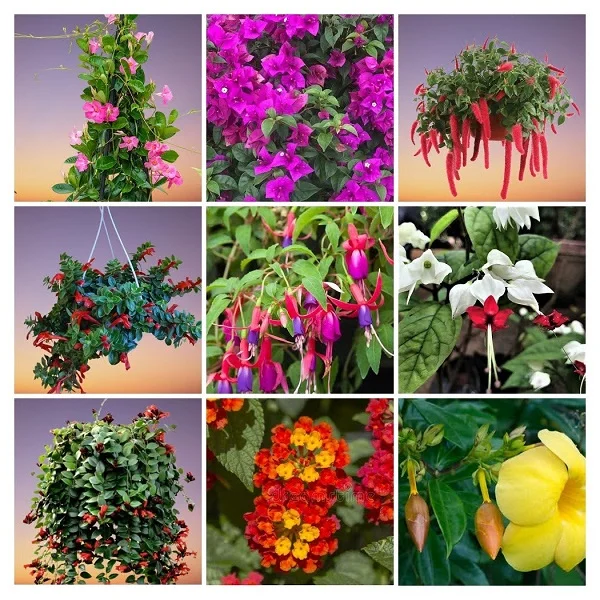Goldfish Plant (Columnea gloriosa) Indoor Care, Propagation and Common Problems
Some links in this post may be affiliate links
Goldfish Plant (Columnea gloriosa) prefers bright indirect light, warm and humid conditions and moderately moist, fertile, well-drained soil coupled with fortnightly feeding in the growing season.
Columnea gloriosa is among the popular flowering plants and bears trailing stems and abundant yellow or orange-red tubular flowers which look like leaping fish and hence the common name.
Goldfish Plant requires a moist atmosphere around the foliage and regular feeding over the growing season. Trimming back of the stems is needed once flowering is over to encourage blooming in the next season.
Though Columnea gloriosa may survive in less than perfect growing conditions, it may begin to drop its leaves and will not bloom in such conditions.

Botanical name: Columnea gloriosa
Family: Gesneriaceae
Common name: Goldfish Plant
Origin
Columnea are native to tropical America and the Caribbean where they grow as epiphytes attached to the tree bark.
How big do Goldfish Plants get?
The stems on Goldfish Plant can grow up to 3 feet and are densely covered by thick, waxy, dark-green leaves which places it among the best plants for a hanging basket, pedestal ot table top where the trailing stems can be allowed to hang down freely.
Is Columnea gloriosa poisonous?
No. According to ASPCA, Columnea gloriosa is non-toxic to humans and pets. It is among the pet-friendly plants that you may grow in any space where there are cats, dogs and other pets.
Varieties
There are numerous species of Columnea. Columnea gloriosa is one of the old favorites. Other popular varieties are;
- Columnea banksii with small, dark-green foliage and yellow marked flowers.
- Columnea microphylla which has 4 feet long stems and Columnea gloriosa like flowers.
- Columnea stavanger with smooth leaves, yellow and red flowers and branching stems but the leaves and flowers are larger.
- Columnea hirta which is a smaller plant with creeping stems and produces flowers very freely.
Where to Buy
If you would like to add Goldfish Plants to your collection, you may obtain them online from Etsy (Link to Etsy).
How to care for Columnea gloriosa Indoors
To care for Columnea gloriosa indoors, give it bright indirect light (filtered light), warmth of 18-260C, humidity of 60-70% and moderately moist, fertile, well-drained potting soil coupled with fortnightly feeding during the growing season.
Goldfish Plant requires trimming back of the stems to rejuvenate growth and encourage blooming. Repotting is only needed when the plant is pot-bound as it blooms best when root-bound. Keep reading for more on these growing conditions and how to provide them.

Watering
How often should I water Goldfish Plant?
Water Goldfish Plant liberally in spring and summer while allowing the top 2-3 inches of soil to dry out between waterings. Keep the soil moderately moist and avoid overwatering to prevent rotting, yellowing and leaf drop.
Water less in fall and winter as growth is minimal at this time. Do not allow the soil to dry out completely as it can result in wilting, yellowing and leaf fall.
Use room temperature water to prevent cold shock which can lead to slowed growth and leaf loss. Only water with chlorine-free water to avoid browning of leaf tips and edges.
Ensure the pot has a drainage hole and the soil is well-draining to prevent waterlogging which can lead to root-rot and death of the plant.
Light Requirements
Does Columnea gloriosa need direct sunlight?
No. Goldfish Plant grows best in bright indirect light; a spot infront of a large brightly-lit window is great for this plant. Shield it or keep it away from direct sunlight to prevent scorching of the leaves.
If the lighting is not sufficient, growth will be reduced, the plant will become leggy and may fail to flower. Therefore, use a full spectrum grow light to supplement it.
Regularly rotate the pot to ensure that the plant receives light on all sides for even growth as well as prevent legginess.
Temperature & Humidity
Goldfish Plant does well in a warmth of 18-260C. Keep it away from drafts to prevent sudden changes in temperature which can result in stunted growth and leaf drop.
Columnea gloriosa thrives in a humidity of 60-70%. Set the pot on a wet pebble tray or use a cool mist humidifier to increase humidity and prevent brown leaf tips and edges. Make sure there is a good air circulation to discourage fungal diseases.
Fertilizer
What is the best fertilizer for Goldfish Plants?
Feed Goldfish Plant with a phosphorous-rich, water-soluble fertilizer every 2-3 weeks in spring and summer to promote a lush growth. Withhold feeding in fall and winter as growth is reduced and it can lead to fertilizer burn.
Once in a while flush out excess fertilizers by running a stream of water through the soil until it comes out through the drainage holes and allow it to run for at least 10 minutes.
Potting Soil
The best soil for Goldfish Plant should be rich in organic matter and free-draining to prevent it from getting soggy while providing the required nutrients. A blend of 2 parts all purpose potting mix and 1 part perlite is ideal for this plant.
Repotting
When to repot a Goldfish Plant?
Repot Goldfish Plant in the beginning of the growing season (spring to early summer), only when the plant is pot-bound as it blooms best when root-bound.
Select a pot that is only one size larger than the current one. Confirm that the pot has a drainage hole and the soil is well-draining to prevent sogginess which can lead to rotting. Check out these pots with drainage holes on Amazon.
Note:Do not repot a plant that is in flower as the repotting shock can shorten the flowering period.
Pruning & Maintenance
How to prune a Goldfish Plant?
Pruning Goldfish Plant involves;
- Removal of dead leaves to maintain the plant neat and tidy and also discourage pests and disease infestations as these are their breeding grounds.
- Removal of the spent flowers to encourage more blooms.
- Pinching off the growing stems to encourage a compact and bushy growth.
- Cutting back the straggly stems at the beginning of the growing season to rejuvenate growth.
Occasionally clean the leaves by damp-wiping with a soft cloth to get rid of dust as well as to discourage pests and diseases infestations.
Columnea gloriosa Propagation
Columnea gloriosa (Goldfish Plant) is propagated from stem cuttings at the beginning of the growing season when the plant is in the active growth phase. The cuttings can be rooted either in water or in soil.
1. Goldfish Plant propagation from stem cuttings in water
- Take a 4-6 inches stem cuttings from a healthy plant. Strip off the lower leaves of the cuttings to expose the stem.
- Coat the lower part of the stem of the cutting with a rooting hormone to hasten establishment.
- Put 2-3 inches of the lower part of the stem of the cuttings in a jar of plain room temperature water or in a propagation station. Make sure the nodes are submerged, but not the leaves.
- Place the set up in a warm, well-lit spot away from direct sunlight. Change the water every 5-7 days to prevent fungal growth.
- Root should appear in 1-2 weeks. When the roots are about 2-4 inches long, transfer the cuttings into individual pots in moist, well-draining soil.
- Position the set up in a warm, well-lit place away from direct sunlight to prevent scorching.
- Maintain the soil moist until there is substantial growth after which you can begin routine care.
2. Goldfish Plant propagation from stem cuttings in soil
- Take 4-6 inches stem cuttings from a healthy plant and strip off the lower leaves.
- Dip the lower cut-end of the cutting in a rooting hormone to hasten rooting.
- Fill a small pot with well-draining soil and moisten it slightly. Use a pot with a drainage hole to prevent rotting.
- Insert 2-3 inches of lower cut-end of the cuttings in the moist soil.
- Place the set up in a warm, well-lit spot away from direct sunlight to prevent scorching.
- Maintain the soil moist through out until the new plants are well established.
- Once well established transplant the new plants into a pot one size larger after which you can begin routine care.

Columnea gloriosa Problems & Solutions
Goldfish Plant (Columnea gloriosa) problems are leaf drop, lack of blooms, yellow leaves, brown leaves, pests and diseases among others. Keep reading for more on these problems and how to fix them.
Leaf drop
Why are the leaves falling off my Columnea gloriosa?
Leaves may be falling off your Columnea gloriosa due to dry air, inconsistent watering, temperature stress, insufficient light, nutrients deficiency or aging.
How to fix it
Dry air: Set the pot on a wet pebble tray, use a cool mist humidifier or group the plants together to raise humidity.
Inconsistent watering: Do not water on a schedule. Water when the top 2-3 inches of soil dry out but never allow the soil-ball to dry out completely.
Temperature stress: Keep the plant away from drafts like windy doors, drafty windows, AC units, hot air vents among others.
Insufficient light: Position the plant in bright indirect light or use a grow light if you do not have enough light in your home.
Nutrients deficiency: Feed the plant with a phosphorous-rich, water-soluble fertilizer every 2-3 weeks in spring and summer.
Aging: This is a natural process. As the lower leaves mature, they turn yellow, brown and eventually fall off.
Lack of blooms
Why is my Goldfish Plant not blooming?
Your Goldfish Plant is not blooming due to too little light, inconsistent watering, soggy soil, nutrients deficiency, temperature stress, dry air or overpotting.
How to to make Goldfish Plant bloom
Too little light: Position the plant in a brighter spot where it will receive bright indirect light or instal a grow light if the natural lighting is not adequate.
Inconsistent watering: Water when the top 2-3 inches of soil dry out. Do not allow it to dry out completely.
Soggy soil: Use a pot with a drainage hole and well-draining soil.
Nutrients deficiency: Feed the plant with a phosphorous-rich, water-soluble fertilizer every 2-3 weeks in spring and summer.
Temperature stress: Keep the plant away from drafts emanating from AC units, windy doors, hot air vents and others.
Dry air: Set the pot on a wet pebble tray, group the plants together or use a cool mist humidifier.
Overpotting: Avoid too frequent repotting; repot only when the plant is extremely pot-bound as it blooms best when root-bound.
Yellow leaves
Some of the causes of yellow leaves on your Goldfish Plant are too little light, soggy soil, underwatering, extreme temperatures, nutrients deficiency or aging.
How to fix it
Too little light: Position the plant in bright indirect light or use a grow light if you do not have sufficient light in your home.
Soggy soil: Use well-draining soil and a pot that has a drainage hole.
Underwatering: Water when the top 2-3 inches of soil dry out but do not allow the soil to dry out completely.
Extreme temperatures: Keep the plant away from sources of drafts like hot air vents, AC units, hot surfaces, windy doors and others.
Nutrients deficiency: Feed the plant monthly in spring and summer with a phosphorous-rich, water-soluble fertilizer.
Aging: This is a natural process. As the lower leaves mature, they turn yellow, brown and eventually die.
Brown leaves
The main causes of brown leaves on your Goldfish Plant are exposure to direct sunlight, inconsistent watering, soggy soil, temperature stress, dry air, salts buildup or aging.
How to fix it
Carefully, remove the brown leaves to keep the plant neat and tidy.
Direct sunlight: Move the plant to a shadier spot or use a sheer curtain to filter the light.
Inconsistent watering: Do not water on schedule; water when the top 2-3 inches of soil dry out. Do not allow the soil to dry out completely.
Soggy soil: Ensure that the soil is free-draining and the pot has a drainage hole.
Temperature stress: Keep the plant away from sources of drafts like AC units, hot air vents, windy doors, stoves and others.
Dry air: To elevate humidity, group the plants together, use a cool mist humidifier or set the pot on a wet pebble tray.
Salts buildup: Once every 2-3 months, leach out excess salts by running a stream of water through the soil until the water drains through the drainage hole.
Aging: This is a natural process. As the lower leaves mature, they turn yellow, then brown and fall off.
Pests
Common pests on Goldfish Plant are spider mites, mealybugs and aphids which are prevalent on weak plants and in dry, stuffy conditions.
How to fix it
- Isolate the affected plant to prevent spread to the rest of the plants.
- Treat the affected plant with neem oil or an insecticidal soap as per the manufacturers' instructions.
- Regularly check underneath and between the leaves for these pests and carry out timely control measures.
- Maintain the plant well pruned and increase humidity to depress the pest infestations.
Diseases
Goldfish Plants are prone to root-rot, botrytis, leaf spot disease and viral diseases. Isolate the affected plant to prevent spread to other plants and treat it appropriately for these diseases.
You liked it? Share on social media.
Related Content
Amazon Associates Disclosure
Homeplantsguide.com is a participant in the Amazon Services LLC Associates Program, an affiliate advertising program designed to provide a means for sites to earn advertising fees by advertising and linking to amazon.com.





